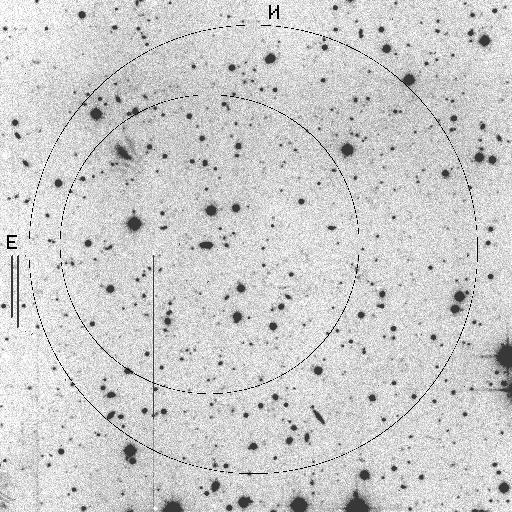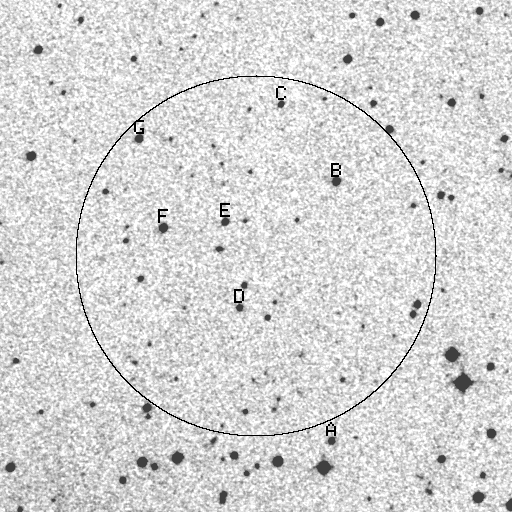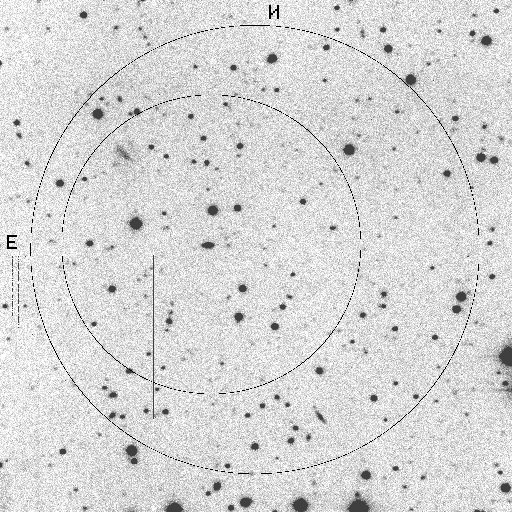On August 6, 1999 a GRB (BATSE trigger 7701) was detected by the
BeppoSAX GRBM and WFC instruments to 3 arcmin accuracy. Follow-up observations
with MECS/LECS revealed a fading X-ray source.
- BeppoSAX GRB alert n. 99/21
On Aug.6, 14:28:07 UT a GRB (GRB990806) was detected
simultaneously by the GRBM and WFC of BeppoSAX (also BATSE trigger 7701).
Preliminary coordinates from WFC are:
R.A.(2000)= 47.632
DEC(2000)= -68.116
with an error radius of about 4'.
- BeppoSAX GRB alert n. 99/22 and GCN notice #392
Refined WFC positions of GRB990806 are
R.A. = 47.6479 degrees = 03h 10m 35.5s
Decl. = -68.1143 degrees = -68d 06' 51.4"
(equinox 2000),
i.e. 0.4' from the previous preliminary position.
The error radius is 3'.
We are planning a follow-up with NFI.
- GCN/RXTE Alert
TITLE: GCN/RXTE_PCA BURST POSITION NOTICE
NOTICE_DATE: Sat 07 Aug 99 00:22:47 UT
NOTICE_TYPE: RXTE-PCA
TRIGGER_NUM: 7701
GRB_DATE: 11396 TJD; 218 DOY; 99/08/06
GRB_TIME: 52086.52 SOD {14:28:06.52} UT
COMMENTS: RXTE-PCA was NOT able to localize this GRB.
COMMENTS: RXTE/PCA observed the position of GRB 990806 determined
COMMENTS: by BeppoSAX (RA=47.632d,Dec=-66.116d)
COMMENTS: betweeen 18:11 and 18:31. No source brighter
COMMENTS: than 0.5 mCrab (3-sigma upper limit) level was detected.
COMMENTS: Toshi Takeshima
- BeppoSAX MAIL n. 99/23 = GCN notice #393
Giangiacomo Gandolfi, on behalf of BeppoSAX Mission Scientist, reports:
A BeppoSAX follow-up of GRB990806 started about 8 hr after the burst.
A quick look analysis of the first orbits of the MECS data at SOC
shows an object, previously unknown, inside the refined
error circle of the WFC.
Preliminary coordinates are:
R.A.(2000)= 47.674
DEC(2000)= -68.113
The error radius is 2'.
BeppoSAX will continue its observation and monitoring of this source
until August 8.
- GCN notice #394
Bradley E. Schaefer (Yale) reports:
I have obtained UBVRIJHK images of the BeppoSAX 2' radius region
(Gandolfi et al., BeppoSAX mail n. 99/23 or GCN 393) for GRB990806.
These observations were made from 1999 August 7 6:57 UT to 10:53 UT (16.48
to 20.39 hours after the burst), with a total exposure time of 5.1 hours
due to the simultaneous integrations in the infrared and optical. The
total integrations times are:
U - 60 min.
B - 64 min.
V - 30 min.
R - 15 min.
I - 15 min.
J - 60 min.
H - 30 min.
K - 33 min.
These images were taken with the Yale 1 m telescope on Cerro Tololo with
the recently upgraded AndiCam IR/optical camera; which is well suited to
obtaining UBVRIJHK of GRB optical transients within the first day or so
after the burst.
No variable source was identified in or near the GRB990806 region.
Comparisons were made between my V, R, and I images with the Digital Sky
Survey, the ESO R sky survey, and the ESO J sky survey. This use of
multiple images and colors for both before and after allowed for the ready
elimination of cosmic rays and color effects which can raise false alarms.
(For example, my R image shows two point sources in the BeppoSAX 2' circle
that do not appear on the Digital Sky Survey despite the indications of
the magnitude; whereas my VRI images show the sources are very red and
both sources do appear near the threshold on the ESO R image.) The area
examined was a region 10.24'X10.24' centered roughly on the BeppoSAX
position. The threshold for reasonable completeness in the comparison is
roughly R=20.5 mag. As always, further analysis can push somewhat deeper,
yet it is clear that any associated optical transient must be close to
this quoted limit if not fainter. I will try to obtain deeper comparison
images tomorrow morning.
- GCN notice #395
J. Kemp, N. Mirabal, J. Halpern (Columbia), J. Parker (SwRI),
D. Harkavy (Harvard), E. Costa, & L. Piro (IAS/CNR, Frascati)
report on behalf of the BeppoSAX team and the MDM Observatory
GRB follow-up team's southern extension:
We imaged the BeppoSAX WFC error circle of GRB 990806 (Piro GCN 392)
starting on Aug. 7.19 UT using the CTIO 4m and 0.9m telescopes.
In a 5 minute V-band exposure on the 4m, no new object brighter
than the limit of the various sky survey plates is seen. The same
is true of a series of ten 10 minute R-band images obtained on the
0.9m between Aug. 7.21 and 7.42 UT. No variable object is seen.
The 5-sigma limiting magnitude of the summed R-band image is 23.0.
Photometric calibration was obtained using the Landolt standard
field of PG 2213-006. For possible future reference, we give
recalibrated magnitudes of several stars from the USNO-A2.0 catalog:
Star RA(2000) Dec(2000) R(USNO) R(CTIO)
-----------------------------------------------------
A 03 10 19.577 -68 09 52.08 16.7 16.83
B 03 10 21.996 -68 05 31.11 16.1 16.09
C 03 10 32.916 -68 04 17.54 16.8 17.07
D 03 10 37.871 -68 07 44.91 17.0 17.15
E 03 10 41.537 -68 06 19.68 16.6 16.50
F 03 10 52.539 -68 06 30.05 15.7 15.58
G 03 10 57.979 -68 05 01.92 16.2 16.33
-----------------------------------------------------
A finding chart for these stars and a CCD image are posted at
http://www.astro.bio2.edu/grb/ and is reproduced below.
Digitized Sky Survey (left) with 3' WFC Error Circle
R-band CCD image from CTIO 0.9m (right) with WFC (3' radius)
and NFI (2' radius) Error Circles
- GCN notice #396
J. Greiner (AI Potsdam, Germany), E. Pompei (ESO, Chile), S. Els (ESO, Chile),
D. Pinfield (Queens Univ. Belfast, Ireland), S. Brillant (ESO, Chile),
M. Sterzik (ESO, Chile), C. Wolf (MPIA Heidelberg), and A. Antonelli
(Rome Obs., Italy) for the BeppoSAX team report:
We have obtained BRI images of the GRB 990806 location (BeppoSAX mail n. 99/22
= GCN #392, BeppoSAX mail n. 99/23 = GCN #393) with
EFOSC at the 3.6 m and the Wide-Field Imager at the 2.2 m telescopes
at La Silla/ESO beginning at 14.5 hrs after the GRB event. The
detailed observations were as follows:
Telescope Start time (UT) Filter Expo.Time
2.2 m 07-08-1999 4:58 R 900 sec
2.2 m 07-08-1999 5:15 R 900 sec
3.6 m 07-08-1999 8:08 B 1500 sec
2.2 m 07-08-1999 9:52 I 1200 sec
2.2 m 07-08-1999 10:14 R 830 sec
3.6 m 08-08-1999 7:36 B 1800 sec
2.2 m 08-08-1999 8:45 R 900 sec
2.2 m 08-08-1999 9:02 R 900 sec
2.2 m 08-08-1999 9:18 R 900 sec
2.2 m 08-08-1999 9:37 I 900 sec
2.2 m 08-08-1999 9:53 I 900 sec
Comparison of the (summed R) images of the two nights do not show any
object with brightness variation more than 0.3 mag down to B = 25.2 mag,
R = 23.5 mag and I = 18.0 mag. Photometric calibration was done against
standard stars in the field SA 113, and the R band calibration is
basically identical to that given in GCN #395.
ESO images, Aug. 8:
B-band (left, 3.6 m EFOSC) and R-band (right, 2.2 m WFI)
- GCN notice #397
J. Kemp, R. Uglesich, N. Mirabal, J. Halpern (Columbia),
D. Harkavy (Harvard), E. Costa (IAS/CNR, Rome) report
on behalf of the BeppoSAX team and the MDM Observatory
GRB follow-up team's southern extension:
We reobserved the BeppoSAX WFC error circle of GRB 990806
(Piro GCN 392; Gandolfi GCN 393) in the R band using the CTIO 0.9m.
A total exposure of 180 minutes was obtained starting on
Aug. 8.31 UT. Seeing was 1".3. The 5-sigma limiting magnitude
of the summed R-band image is 23.8. No variable object is
detected in comparison with images obtained on the previous night
(GCN 395). Using a sensitive difference imaging technique,
we set a limit of R > 23.3 on Aug. 7.3 for any fading optical
transient in the WFC error circle. This is consistent with the
R-band limit of 23.5 set by the ESO 2.2m (Greiner et al. GCN 396).
The new image is posted at
http://www.astro.bio2.edu/grb/ and reproduced below.
R-band CCD image, CTIO 0.9m, Aug. 8:
180 min. exposure

- GCN notice #398
P.M. Vreeswijk (U. of Amsterdam), E. Palazzi, E. Pian, F. Frontera
(ITESRE, CNR, Bologna), M. Bessell (Mount Stromlo Obs.), J. Hjorth, B.
Milvang-Jensen, H. Pedersen (CUO, Copenhagen), J. van Paradijs (U. of
Amsterdam and U. of Alabama in Huntsville), and C. Kouveliotou
(USRA/MSFC) report on behalf of the Bologna/Rome, Amsterdam/Huntsville
and Copenhagen GRB optical follow-up teams:
We have observed the error box of GRB990806 (Piro 1999, GCN 392) at the
40inch telescope at the Siding Spring Observatory (3.8 hours after the
burst) and at the ESO Danish 1.54m telescope. A log of the observations
is reported in the following Table:
Date Telescope ExpoTime Band Lim.mag.
(UT) (min) (5 sigma, ap. rad.=FWHM)
1999 August 6.76 40inch 40 R 22.0
August 6.80 40inch 60 B 21.5
August 7.24 1.54m+DFOSC 50 R 22.8
August 7.40 1.54m+DFOSC 10 B 22.4
Comparison between the 40inch images and Danish images does not reveal a
source varying by more than 0.3 magnitudes both in the R and B band.
The ESO Danish R-band image can be inspected at
http://tonno.tesre.bo.cnr.it/~pian/grb/grb990806.html
- GCN notice #399
J. Prochaska, I. Thompson (OCIW), J. S. Bloom, F. A. Harrison,
S. R. Kulkarni (CIT), D. A. Frail (NRAO) report: "On the night of 7
August 1999 UT, we imaged the field of GRB 990806 (Piro GCN #392;
Gandolfi GCN #393) with the Swope 40-inch telescope at Las Campanas
Observatory. The total integration time was 900-s in R (approximately
Cousins) and the mean epoch was 7.4186 August 1999 UT. Photometric
comparison with secondary standards from Kemp et al. (GCN #395) yields
a 3-sigma point source detection threshold of R~=22.5. In agreement
with previously reported measurements (GCN #394; GCN #395; GCN #396;
GCN #397; GCN #398), we find no new sources not present in the Digital
Sky Survey.
A 4'x4' image of the field centered on the BeppoSAX position can be
obtained at
http://www.srl.caltech.edu/~fiona/grb990806.html
The reduced, medianed frame can be obtained at
http://www.srl.caltech.edu/~fiona/grb990806-aug7-lco-rband-900s.fits
- GCN notice #400
T. Giblin, G. Richardson, and R. M. Kippen (University of Alabama
in Huntsville) report on behalf of the BATSE GRB Team:
GRB990806 was detected by BATSE on 1999 August 6.60285 UT as trigger
7701. The time profile of the burst exhibits a FRED-like structure
(fast rise and slower decay) with some variability on shorter time
scales. The T50 and T90 durations are 4.93 (+/- 0.26) and 17.41
(+/- 3.84) seconds, respectively. The peak flux of the burst,
integrated over 1.024 s in the 50-300 keV range, is 1.60 (+/- 0.05)
photons cmE-2 sE-1, placing it in the top 28% of the BATSE peak flux
distribution. The fluence (>20 keV) of the burst is 3.29 (+/- 0.53)
x 10E-6 erg cmE-2, ranking it in the top 43% of the BATSE fluence
distribution. The average spectral hardness of the burst (H32), as
determined by the ratio of total counts in the 100-300 keV to the
50-100 keV range, is 0.811 (+/- 0.034), average for BATSE GRBs of
this duration. The BATSE location error circle (90% conf.) is
slightly offset (~2 degrees) from the BeppoSAX WFC location (GCN 393).
The lightcurve and skymap location that includes the WFC and BATSE
locations for this event (and other notable GRBs) are available at
the BATSE Rapid Burst Response world-wide-web site:
http://www.batse.msfc.nasa.gov/~kippen/batserbr/
- GCN notice #401
F. Frontera, Istituto TESRE, CNR, Bologna and University of
Ferrara, Italy; M. Capalbi, M.R. Daniele, A. Malizia, M. Perri, BeppoSAX
SDC, Rome, Italy; E. Montanari, University of Ferrara, Italy; M. R.
Daniele, A. Paolino, R. Ricci, G. Tarei, A. Tesseri, BeppoSAX SOC,
Rome, Italy; C. Pastor, M. Stornelli, SAX-OCC, Rome, Italy; E. Pian,
Istituto TESRE, CNR, Bologna, Italy; G. Gandolfi and L. Piro, IAS,
CNR, Rome, Italy, on behalf of a larger collaboration, report:
The BeppoSAX Wide Field Camera error box of GRB990806 BeppoSAX MAIL n.
99/22 and GCN #392) was observed with the BeppoSAX Narrow Field
Instruments (NFI) starting about 8 hrs after the burst in the period Aug.
06.9267-08.6563 UT. Preliminary analysis of MECS2+3 data shows a
previously unknown X-ray source, 1SAX J0310.6-6806, located at RA =
03h10m35s, Dec = -68o06'35'' (equinox 2000.0), with an error radius of 1'.
This position is very close to the centroid of the WFC error box. During
the observation, the 1.4-10 keV source flux decreases by a factor 4,
from (8.6 +- 2.4)x10E-3 cts/s, corresponding to (5.5 +- 1.5)x10E-13 erg
sE-1 cmE-2 to (2.3 +- 0.6)x10E-3 cts/s corresponding to
(1.5 +- 0.6)x10E-13 erg sE-1 cmE-2. For comparison a ROSAT source, 1RXS
J031250.0-680915, out of the WFC error box but visible in the same MECS
image, does not show any statistically significant variation during the
entire observation. We conclude that 1SAX J0310.6-6806 is likely the X-ray
afterglow of GRB990806.
![]() Previous IAU Circulars
Previous IAU Circulars 



